Ever since I worked the Boulder County Fair at the beginning of August, I'd realized I was going to have to harvest all the supers at the end of August or the beginning of September. It was pretty clear that if the supers were taken, then the bees would start filling the brood box with honey instead of the extra space I was giving them.
I'd been thinking of just leaving the honey for the bees, and not dealing with extraction and all the extra equipment that implied, since I hadn't really been going into it for the honey so much as for the simple fact that the bees were alive and pollinating. But the display kind of convinced me, and I talked with a man who sells honey at our local farmer's market. He said that now was the time to take the supers off, so that the bees would have the time to fill the brood chambers while it was still warm. My mentor from the 911 center said that he found that the winter bee cluster rarely ever made it as far up as the supers, so they would never reach the honey if we left if for them. So he always takes away all the supers around now.
On Monday it had been in the 80's and low 90's lately, and the weatherman said that it was going to stay in that range for the next week, but then the temperatures were likely to drop for a while. John was leaving on Tuesday to pick up the van, and I needed him along in case something happened. So it seemed the right thing to do. Besides, I wasn't going to say no to a little honey.
What I didn't really know was how MUCH I'd get.
The first thing I had to do was pull out the sticky board and see how the girls had done with respect to their mite load. I was pretty impressed, since I'd left it there since the last time I went in, and it's been about two weeks. There were mites! But not very many of them.
The bees had also managed to find their way into the space between the bottom of the sticky board and the screen, somehow, along with that enormous spider from last time. But the cool thing was finding that while there were mites, there weren't that many of them given the amount of time the board had been in the hive.
So I just cut and Vaselined another piece of cardboard, and got that back into the bottom of the hive before I started anything else. And I wrote myself a plan. *laughs* I decided that I was going to take off the supers, reducing their room to just the two brood deep boxes, and then I was going to do the powdered sugar treatment since there *were* mites, but not huge number of them.
Suiting up and going in was less of an adrenaline rush for me, this time through. It is now routine, to the point where I decided I really didn't have to have the thick wool socks that I usually use to protect my ankles. The suit I have actually covers my ankles pretty well if I pull the elastic cuffs over my boots.
I had ordered a "Bee Escape" at the beginning of last week, but it still hadn't shown up, so I figured I'd just pull the frames by hand, one at a time, get all the bees off between the window cleaning brush, the smoke, and just blowing them off with a puff of breath, it worked out just fine. It was a lot of work, as there were a lot of bees in the deep super I'd put on top of the brood supers.
The smaller, medium super, which I'd bought from Corky in Seattle, wasn't even really touched. They hadn't built comb in it and while there were a few bees crawling around in it, they'd really concentrated on the deep super. That surprised me, a little, but given that I'd put it on before the bees had capped off the deep super, it actually followed more professional procedure, since the experienced keepers talk about NOT putting another super on until the one below it is filled and capped. This is, of course, counter to those that say, no no, put two supers on a once, it'll encourage them to produce more.... two beekeepers, three opinons...
Really, truly concentrated on it. They filled every frame and completely capped off four of the eight frames. Of the other four, one was three-quarters capped, two were half-capped, and the last was one quarter capped. Usually the bees let the honey dry until it's dense "enough" and then cap it to keep it, so the uncapped frames had mildly more water than the capped ones. This one, as you can see, was one of the fully capped ones.
These were also old frames from previously used equipment, and when I used my hive tool to lever at the top bar of a few of the frames, the whole top bar came off! The nails that were driven down into the frame bars below just came clean out of the wood. The bottom of the frame had been glued into the sides of the box by the bees, using propolis (a sticky blend of beeswax and tree sap). I was not happy about *that*! But I knew that it might be a problem because the honey-filled frames were *heavy*, and with the extra gluing by the bees, it just felt inevitable.
I pulled one frame, the second one lost its top bar. I then got two more frames out, and the next one lost its top bar, too! I got mildly frustrated at that point, and since I had enough room in the box for my arm to fit between the two broken frames, I put my gloved hand down in there, and tried to wiggle my fingers so that the bees could get away from my hand. Then I started to lift the frame with the bottom bar.
I got stung through my protective glove, twice. So much for those gloves doing what I thought they were doing. The girls got me right through a two-layer of leather, too, which just bemused me. I shouted in pain, and the whole pitch of the hive went up. Going with the better part of valor, I walked away from the whole hive, and brought my smoker with me.
We relit the smoke, got a compress of baking soda onto the stings, and then I wrapped the compress with a tissue and stuck my whole hand back into the glove. Then I went right back to the box, smoked everyone to heck and back, and then reached in again and slowly, gently, pulled the broken frame out of there, blew the remaining bees off gently, and then handed the whole thing to John.
And then I went back in for the other one, and it was a little easier, because I could see under that particular frame. I got the rest of them out of there with relatively little trouble, and the empty box was filled with bees clinging to the sides. I banged it, once, over the brood box, and covered all the top bars with bees.
With all the bees piled up on there, I got the one-third cup of sifted powdered sugar out, and started sprinkling it between the top bars. As you can see here, the pile of bees quickly worked their way into the box and out the various openings they were given.
There were ghost bees everywhere.
John walked the empty frames into the garage, and I closed up shop, using the brush to just get the bees off the top rim all around the box. I used to worry so much about crushing them when I put the inner lid on, now I just use the brush and it works wonders. The inner and outer lids went on, and I got to walk away, put away all my tools, and find some iced tea and the neighborhood pool to cool off. It was mid-90's, and the sun was shining, so I was dripping with sweat when I finished.
That evening John and I tried to figure out how to harvest the honey. I'd learned a little from the small piece I'd taken a month ago, and I wasn't going to invest in an extractor or in borrowing equipment from either club I belong to. With only eight frames setting them up and cleaning them afterward seemed like a lot of work to do for what was relatively little honey.
So instead of doing all that, we just got out a sheet pan, a knife and an offset spatula, and pulled the foundation with all its honeycomb out of one of the broken frames. With the tools we just scraped the honeycomb off the foundation, onto the sheet pan. The caps came off each of the cells when we pushed the honey along. I was amazed how much of what came off was just pure liquid honey. The wax holding everything together was relatively light and small in volume. The plastic foundation also had the cells pressed into the plastic, so they couldn't be scraped off! I was very grateful for that.
Once the honeycomb was off the foundation, it looked something like this... and once it wasn't on its support, it collapsed beautifully, and the honey flowed from it. It was clear and beautiful and all the wax bits were relatively large.
One of those cool things is that the bees themselves kept all of these honey combs completely separate from the brood chamber, where the queen lays eggs, which hatch into larva, which spin tiny cocoons in their cells, and then are born as newly hatched bees. When the baby bees are born, they clean out their own cell, and then go on to take care of the larva and feed them the bee bread they make from pollen and honey.
But none of that procreation action happens up in the supers! I didn't even put a queen excluder in this year, because it looked like they weren't going to lay up in the honey levels, and sure enough, they didn't! That amazes me, still, how the whole system really takes full advantage of honeybee nature.
So all there was in the half-sheet pan, after we scraped off all the comb, was big pieces of wax and clear honey....
So we just poured it all into a fine sieve, and let the honey just flow through and down into the jars. And as you can see, it worked just fine! John had the filters for his beer making, and he has to filter out grain husks, hops, and other plant material, and it worked out great for what we were doing here, and the plastic mesh was fine enough to keep just about everything other than the honey out of the jars. Still, this is raw, unfiltered honey, as we don't put it through a super-fine mesh that would take out all the pollen and everything.
This is most of the take. There were three more quarts and a single pint that came off the foundations, the wax mound, and the half-sheet pan when I got them into warmer temperatures. I was amazed at how much came off the wax! One and a half of those quarts were just from letting it sit overnight and being patient with it.
I then spent the next day cleaning off all the equipment, because the beeswax really liked sticking to the plastics we used. Oops. I ended up melting a lot of it off the equipment, using a big pot of water in a clean pot. The pot picked up a lot of wax, too, but I was able to skim the majority of it off the top of the water and scrape it off the sides before using a Wax Off solution on the steel. It cleaned up nice, but I'm going to be looking for a coffee can to actually melt what wax I end up with when the bees are done picking the last of the honey from the mass.
One bee girl came in with all the equipment when I went to wash the sieves, and she crawled up out of the kitchen sink onto the lip of the sink. She stretched like a cat, head, torso, and a flip of a sting-tipped tail section. All her tiny legs and wings stretched, too, and then she kind of looked at me expectantly. I proffered a bottle brush I'd been using on the jars, and she stepped lightly onto it, and started strolling toward me. I got the brush and her outside onto the back porch and set her down gently. She then took off for her hive.
The girls have been cleaning off the empty frames, the foundation after I got one last honey flow off it, and the ball of comb wax sitting in a bowl. And they're very very enthusiastic about their work. I was really impressed by how utterly clean they made the foundation pieces, and they got every drop of honey off the deck. And there was a huge cloud of them working their way across all available surfaces. There were also a large number of wasps moving in among them, and I'd find the occasional beheaded bee here or there, when a wasp had had enough of someone. The odd thing was that the wasps weren't taking them off to eat them, too.
I'll admit that I did kill a few wasps when the opportunity presented itself, and it was interesting to note that the bees didn't react to that at all, but the few wasps among them reacted quite aggressively. I did have my suit on while I was moving equipment around, so no more stings, but... wow. There was quite the cloud of all the insects on the porch while I was making our dinner on the grill outside. So last night I moved everything over closer to the hive, and by mid-day today, the bees and wasps had all cleared out.
I've ended up with nearly 30 pounds of honey! And there are a large number of neighbors and people who want to buy it from me, so I may make back some of the money I spent on equipment! That would be amazingly nice, to be able to almost break even on my expenditures for the year.


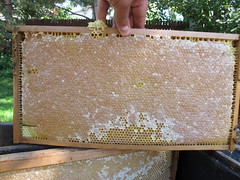
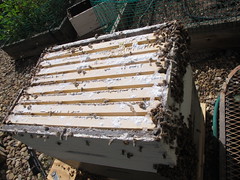
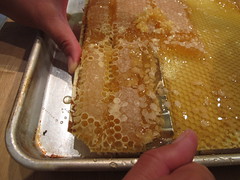
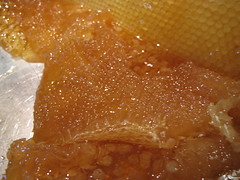
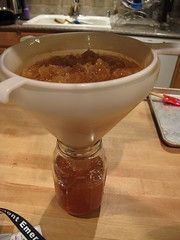

No comments:
Post a Comment